1993 CHEVROLET CAMARO towing
[x] Cancel search: towingPage 64 of 358
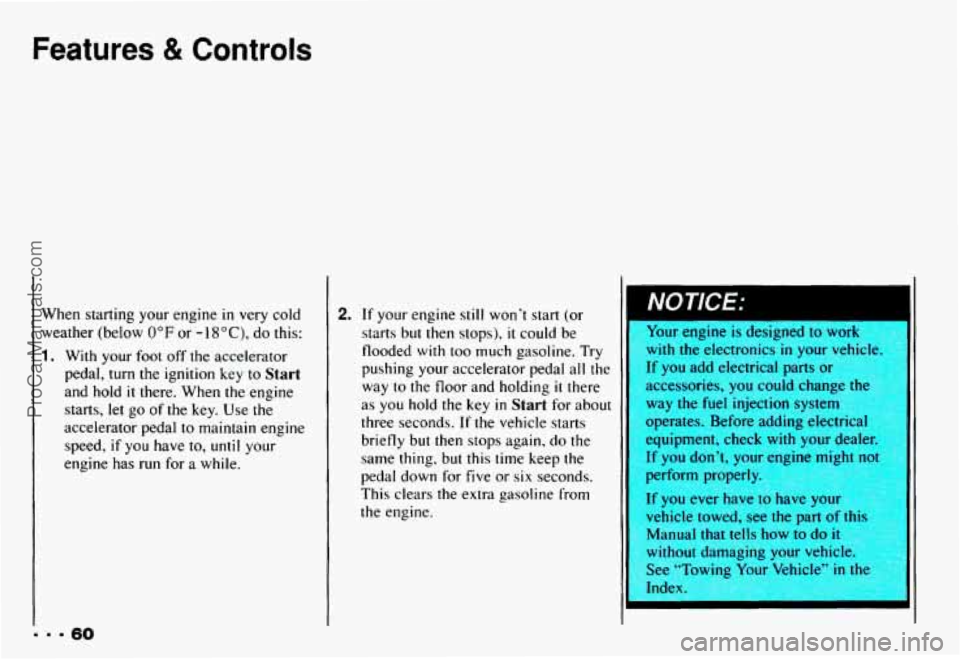
Features 8t Controls
When starting your engine in very cold
weather (below
0°F or - I SOC), do this:
1. With your foot off the accelerator
pedal,
turn the ignition key to Start
and hold it there. When the engine
starts, let go of the key. Use the
accelerator pedal to maintain engine
speed,
if you have to, until your
engine has run for
a while.
2. If your engine still won’t start (or
starts
but then stops), it could be
flooded
with too much gasoline. Try
pushing your accelerator pedal all the
way to the floor and holding
it there
as you hold the key in Start for about
three seconds.
If the vehicle starts
briefly but then stops again, do the
same thing, but this time keep the
pedal down for five or
six seconds.
This clears the extra gasoline from
the engine.
NOTICE:
1 Your engine is designed to work
with the electronics in your vehicle.
If you add electrical parts or
accessories, you could change
th
way the fuel injection system
operates. Before adding electrlcal
equipment, check with your dealer.
II
If you don’t, your engine might not
perform properly.
If you ever have
to have your
vehicle towed, see the part
of thi
Manual that tells how to do it
without damaging your vehicle.
See “Towing Your Vehicle’’
in th
Index
I I
ProCarManuals.com
Page 66 of 358

Features & Controls
I NOTICE:
I HTI~~ you-ve usea me DIOCK neater, I- sure to store the cord as it was
,-fore, to keep
it aw-f from movin
engine parts.
If you h’t ; $&add ,$a;!$$$,.
be damaged.
I
, . ,Q i ,,<.> . , t!!! h,~
I
How long should you keep the block
heater plugged in? The answer depends
on the weather, the kind of oil you have,
and some other things. Instead of trying to
list everything here, we ask
that you
contact
a Chevrolet dealer in the area
where you’ll be parking your vehicle. The
dealer can give
you the best advice for
that particular area,
... 62
Automatic
Transmission
There are several different positions for
your shift lever.
P (Park)
This locks your rear wheels. It’s the best
position to use when you start your
engine because your vehicle can’t move
easily.
It is dangerous to get out of
your vehicle
if rhe shift lever is
not fully in P (Park) with the
parking brake
firmly set. Your
vehicle can roll.
Don’t leave your vehicle when the
engine
is running unless you have
to. If you have left the engine
running, the vehicle can move
suddenly.
You or others could be
injured. To be sure your vehicle
won’t move, when you’re on fairly
level ground, always set your
parking brake and move the shift lever to
P (Park).
See “Shifting into
P (Park)” in the
Index.
If you are parking on a hill,
or if you’re pulling a trailer, also
see “Parking on Hills” or “Towing
a Trailer” in the Index.
ProCarManuals.com
Page 68 of 358

Features & Controls
.
Shifting out of Y (Park) or
N (Neutral) while your engine
13 “racing” (running at high speed)
is dangerous. Unless your foot is
firmly on the brake pedal, your
vehicle could move very rapidly.
You could lose control and
hit
people or objects. Don’t shift out of
P (Park) or N (Neutral) while your
engine
is racing.
I I Damage to your transmission
caused by shifting out of P (Park) o
N (Neutral) with the engine racin;
isn’t covered by your warranty. ~ I
@ Automatic Overdrive
This position is for normal driving. If you
need more power for passing, md you’re:
- Going less than about 35 mph
(56 km/h), push your accelerator You’ll
shift down
to the next gear and
have more power.
D (Third Gear)
This is like @I , but you never go into
Overdrive.
Here are some times you might choose
D
instead of @ :
- When driving on hilly, winding roads
- When towing a trailer. so there is less
shifting between gears
pedal abou; halfway down.
I- When going down a steep hill
- Going about 35 mph (56 km/h) or
more, push the accelerator all the way
down.
ProCarManuals.com
Page 75 of 358

If you are on a hill: See “Parking on
Hills” in the Index. That section shows
how to turn your front wheels.
If you are towing a trailer and are
parking on any
hill: See “Towing a
Trailer”
in the Index. That section shows
what
to do first to keep the trailer from
moving.
Shifting into P (Park)
(AUTOMATIC TRANSMISSION)
It can IX aangerous to get out
- of your vehicle if the shift lever
is not fully in P (Park) with the
parking brake firmly set. Your
vehicle can roll.
If you have left the engine running,
the vehicle can move suddenly.
You
or others could be injured. To
be sure your vehicle won’t move,
when you’re on fairly level ground,
use the steps that follow. If you are
parking on a hill, or if you’re
pulling
a trailer, also see “Parking
on Hills” or “Towing a Trailer” in
the Index.
1. Hold the brake pedal down with your
2. Move the shift lever into P (Park)
right foot and set the parking brake.
position like this:
Hold in the button on the lever,
and push the lever all the way toward the front
of your vehicle.
3. Move the ignition key to LOCK.
4. Remove the key and take it with you.
If you can walk away from your
vehicle
with the ignition key in your
hand, your vehicle is
in P (Park).
ProCarManuals.com
Page 77 of 358
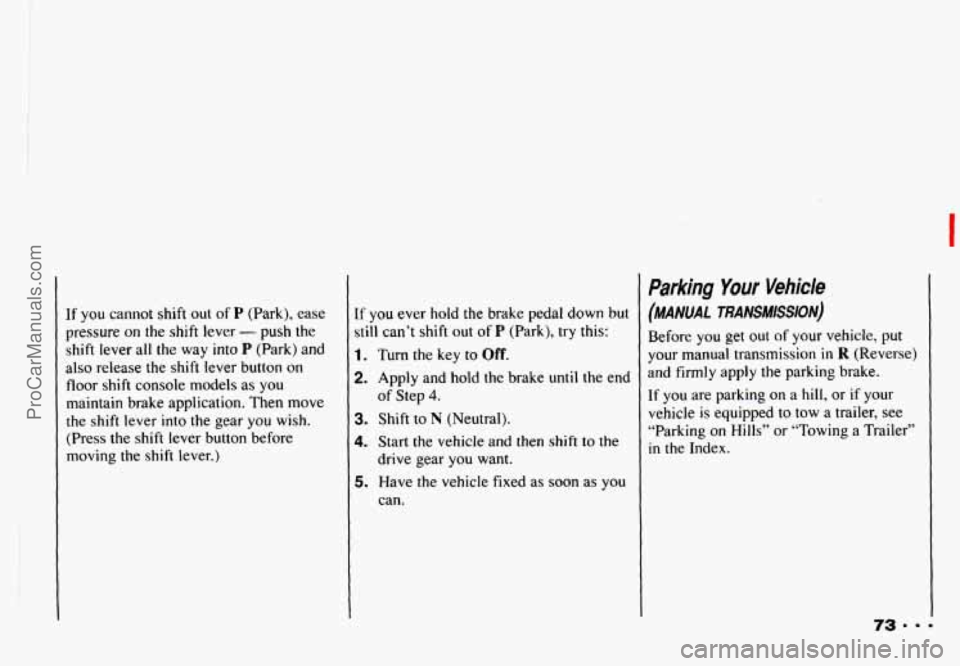
I
If you cannot shift out of P (Park), ease
pressure
on the shift lever - push the
shift lever all the way into
P (Park) and
also release the shift lever button on
floor shift console models as you
maintain brake application. Then move the
shift lever into the gear you wish.
(Press the shift lever button before
moving the shift lever.)
If you ever hold the brake pedal down but
still can’t shift
out of P (Park), try this:
1. Turn the key to Off.
2. Apply and hold the brake until the end
3. Shift to N (Neutral).
4. Start the vehicle and then shift to the
drive gear
you want.
5. Have the vehicle fixed as soon as you
of
Step 4.
can.
Parking Your Vehicle
(MANUAL TRANSMISSION)
Before
you get out of your vehicle, put
your manual transmission
in R (Reverse)
and
firmly apply the parking brake.
If you are parking on a
hill, or if your
vehicle is equipped to tow a trailer, see
“Parking on Hills”
or “Towing a Trailer”
in the Index.
ProCarManuals.com
Page 79 of 358
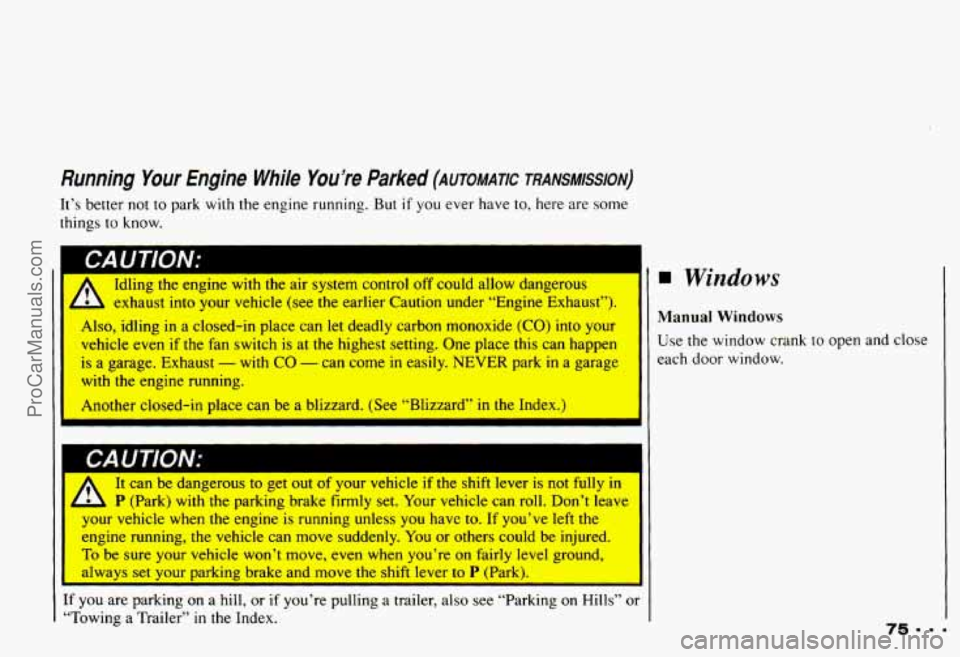
Running Your Engine While You’re Parked (AUTOMATIC TRANsMIssIoN)
It’s better not to park with the engine running. But if you ever have to, here are some
things
to know.
1 CAUTION:
umg tne engme wltn tne alr system control OII coula allow aangerous
L exhaust into your vehicle (see the earlier Caution under “Engine Exhaust”).\
Also, idling in a closed-in place can let deadly carbon monoxide
(CO) into your
vehicle even if the fan switch is at the highest setting. One place this can \
happen
is a garage. Exhaust - with CO - can come in easily. NEVER park in a garage
with the engine running.
Another closed-in place can
be a blizzard. (See “Blizzard” in the Index.)
11 can oe udngeruus LO gel out 01 yuur veriiue 11 lhe sriill lever is riui rully in
I L P (Park) with the parking brake firmly set. Your vehicle can roll. Don’t leave
your vehicle when the engine is running unless you have
to. If you’ve left the
engine running, the vehicle can move suddenly. You
or others could be injured.
To be sure your vehicle won’t move, even when you’re on fairly level ground,
always set your parking brake and move the shift lever
to P (Park).
C you are parking on a hill, or if you’re pulling a trailer, also see “Parking on Hills” or
Towing a Trailer”
in the Index.
Windows
Manual Windows
Use the window crank
to open and close
each
door window.
ProCarManuals.com
Page 105 of 358
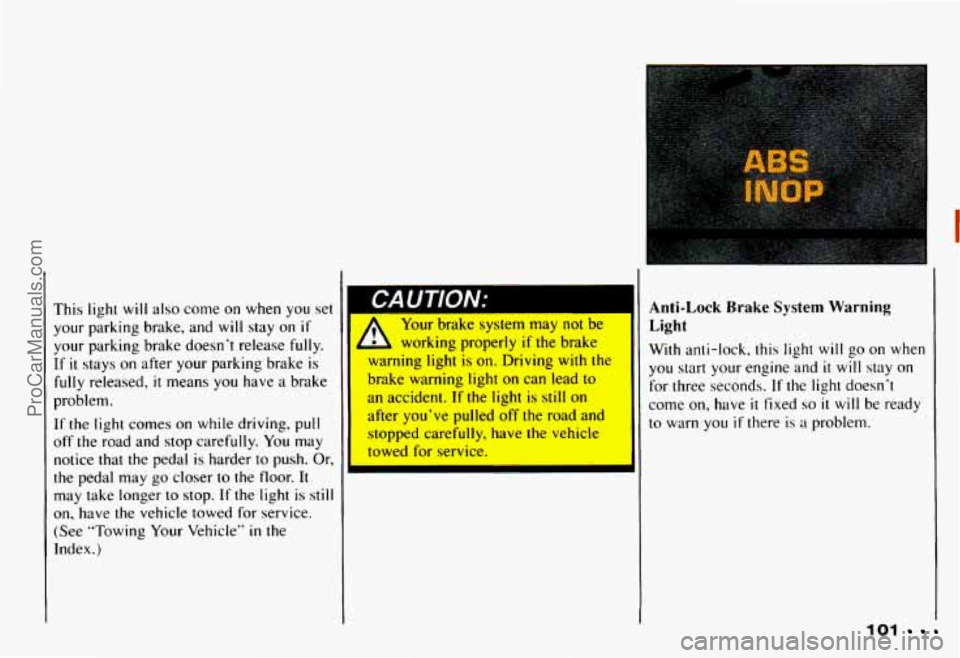
I
This light will also come on when you set
your parking brake, and will stay on
if
your parking brake doesn’t release fully.
If it stays on after your parking brake is
fully released, it means you have a brake
problem.
If the light comes on while driving, pull
off the road and stop carefully. You may
notice that the pedal is harder to push. Or,
the pedal may
go closer to the floor. It
may take longer to stop.
If the light is still
on, have the vehicle towed for service.
(See “Towing Your Vehicle”
in the
Index.)
I
CAUTION: II ____~
Your brake system may not be
working properly if the brake
warning light is on. Driving
with the
brake warning light on can lead to
an accident. If the light is still
on
after you’ve pulled off the road and
stopped carefully, have the vehicle
towed for service.
I
Anti-Lock Brake System Warning
Light
With anti-lock, this light will go on when
you start your engine and
it will stay on
for three seconds.
If the light doesn‘t
come
on, have it fixed so it will be ready
to warn
you if there is a problem.
101
ProCarManuals.com
Page 135 of 358
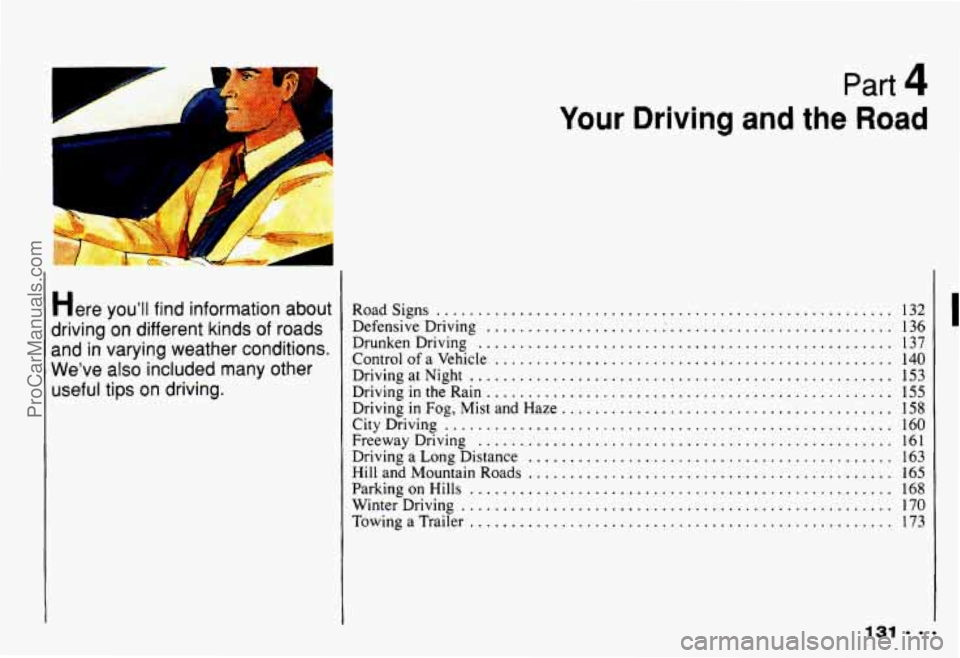
Part 4
Here you’ll find information about
driving on different kinds
of roads
and in varying weather conditions
.
We’ve also included many other
useful tips
on driving .
Your Driving and the Road
Roadsigns .......................................................
Defensive Driving ..................... t ...........................
DrunkenDriving ..................................................
Control of a Vehicle ................................................
DrivingatNight ...................................................
Driving in the Rain .................................................
Driving in Fog, Mist and Haze ........................................
Driving a Long Distance ............................................
Winter Driving ....................................................
Towing a Trailer ...................................................
CityDriving ......................................................
FreewayDriving ..................................................
HillandMountainRoads ............................................
ParkingonHills ...................................................
132
136
137
140
153
155
158
160 161
163
165
168
170
173
ProCarManuals.com